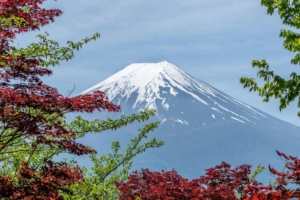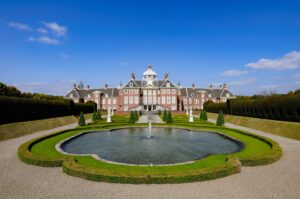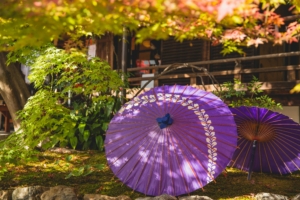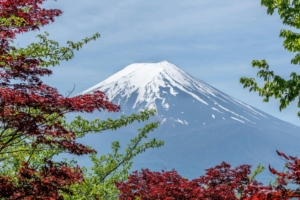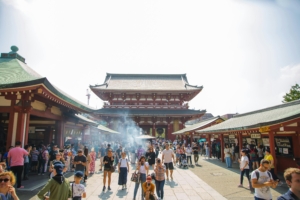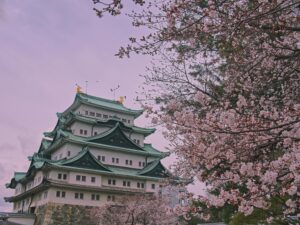Introduction to Kinkaku-ji Temple
Kinkaku-ji Temple, also known as the Golden Pavilion, is a historic and visually stunning structure located in Kyoto, Japan. This Zen Buddhist temple is renowned for its beautiful gold-leaf-coated exterior which reflects beautifully in the pond before it, making it one of the most popular tourist attractions in Japan.
The temple’s history dates back to the late 14th century, originally constructed as a retirement villa for Shogun Ashikaga Yoshimitsu. It was later converted into a Zen temple by his son, according to his wishes. The architecture of Kinkaku-ji is a magnificent example of the Muromachi period’s design, which harmonizes the Japanese concept of wabi-sabi (the beauty of imperfection) with the grandeur of gold.
- Opening Hours: Kinkaku-ji is open from 9:00 AM to 5:00 PM daily.
- Entrance Fee: A small fee is required for entry, which contributes to the temple’s maintenance.
- Best Time to Visit: The temple is stunning year-round, but it is particularly breathtaking during the autumn when the surrounding gardens are ablaze with the colors of the changing leaves, and in winter when the golden pavilion contrasts with the white snow.
- Access: Kinkaku-ji can be accessed via bus from Kyoto Station. Visitors can take bus numbers 101 or 205, which directly stop at the temple.
Despite the wealth of information available online, many visitors appreciate real-time updates and personal stories from those who have experienced the temple firsthand. Incorporating visitor reviews and personalized content can enhance the experience for future visitors, making planning their visit easier and more engaging.
For those looking to explore Kinkaku-ji, it’s recommended to allocate at least an hour to fully appreciate the temple grounds and the detailed architecture. Don’t forget to check for any seasonal events or special openings that might enhance your visit.
The significance of Kinkaku-ji in Japanese culture
Kinkaku-ji Temple, also known as the Golden Pavilion, is a quintessential symbol of Kyoto and a masterpiece of Japanese architecture. This Zen Buddhist temple is renowned for its stunning gold-leaf-coated exterior which reflects beautifully in the pond before it, creating a breathtaking view that attracts millions of visitors each year.
The temple’s significance in Japanese culture can be traced back to its historical and artistic value. Originally built in 1397 as a retirement villa for Shogun Ashikaga Yoshimitsu, it was converted into a Zen temple after his death. Over the centuries, Kinkaku-ji has survived numerous challenges, including being burnt down several times in wars and conflicts.
Today, Kinkaku-ji is not only a popular tourist attraction but also a potent symbol of peace and harmony. Its presence in Japanese culture is pervasive, appearing in various forms of media, literature, and art. It serves as a testament to the artistic and cultural achievements of Japan’s Muromachi period, influencing not only Japanese but also global perceptions of beauty and architecture.
The temple’s design, which incorporates three distinct styles of architecture—Shinden, Samurai, and Zen—each representing a different floor, symbolizes a fusion of secular and spiritual beauty. The top two floors are covered in gold leaf, which highlights the importance of the temple in Japanese culture and the extravagance of the Muromachi period.
Furthermore, Kinkaku-ji is a source of inspiration for many due to its resilience and enduring beauty. It teaches the values of reflection and the importance of maintaining balance with nature, as seen in its harmonious integration with the surrounding garden and pond.
In conclusion, Kinkaku-ji is more than just a temple; it is a cultural icon that embodies the aesthetic values and historical depth of Japan. Its golden shimmer continues to captivate the hearts of those who visit, making it a perpetual symbol of Japan’s rich cultural heritage.
Essential Visitor Information for Kinkaku-ji Temple
Planning a visit to the iconic Kinkaku-ji Temple in Kyoto? Here’s everything you need to know to ensure a memorable and smooth experience.
| Opening Hours | 9:00 AM to 5:00 PM daily |
|---|---|
| Entrance Fee | 400 yen for adults, 300 yen for children |
| Best Time to Visit | Early morning or late afternoon to avoid crowds |
| Access | Accessible via Kyoto City Bus from Kyoto Station |
Historical Insight: Kinkaku-ji, also known as the Golden Pavilion, is a Zen Buddhist temple that is one of Kyoto’s most enduring historical landmarks. Its top two floors are completely covered in gold leaf and it is surrounded by a serene pond, making it a stunning sight regardless of the season.
- Check the official website for any seasonal events or special openings.
- Consider visiting during autumn or spring for a breathtaking view of the surrounding gardens in full bloom or vibrant fall colors.
- Take advantage of the less crowded early mornings for a more personal experience and stunning photography opportunities.
For a deeper connection with Kinkaku-ji, explore personal stories and reviews from past visitors to get a sense of the temple’s impact and the spiritual ambiance it offers. Engage with interactive content like virtual tours or quizzes to enhance your understanding and appreciation of this historic site before your visit.
Kinkaku-ji Temple Opening Hours
Planning a visit to the iconic Kinkaku-ji Temple in Kyoto? Knowing the opening hours is essential to ensure you make the most of your trip. Kinkaku-ji, also known as the Golden Pavilion, is one of Japan’s most cherished historical sites, attracting visitors from around the world with its breathtaking beauty and serene landscape.
General Opening Hours: Kinkaku-ji Temple is open to the public almost every day of the year. Typically, the temple gates are open from 9:00 AM to 5:00 PM. These hours may vary slightly during special events or under certain circumstances, so it’s always a good idea to check the official website or contact the temple directly before your visit.
- Spring and Summer: The temple grounds tend to be more crowded during the cherry blossom season in spring and the lush green months of summer. Arriving early can help you avoid the largest crowds.
- Autumn and Winter: Autumn brings stunning fall colors to the temple’s surroundings, making it a popular time for photography. Winter, especially when the pavilion is dusted with snow, offers a unique and tranquil beauty.
Visitors should also be aware of national holidays and special events, as these can influence the number of visitors and the opening hours. For the most current and detailed information, visiting the official Kinkaku-ji Temple website or contacting them directly is recommended.
By aligning your visit with the opening hours and considering the seasonal variations, you can experience Kinkaku-ji Temple in a way that suits your travel preferences and helps you capture the best of this historic site.
Kinkaku-ji Temple Entrance Fee
When planning a visit to the iconic Kinkaku-ji Temple in Kyoto, one of the essential details to consider is the entrance fee. This beautiful Zen Buddhist temple, also known as the Golden Pavilion, attracts visitors from around the world with its stunning architecture and serene gardens.
Current Entrance Fee: As of the latest update, the entrance fee for Kinkaku-ji Temple is 400 yen for adults and 300 yen for children. This fee helps in the maintenance and preservation of the temple grounds and contributes to the conservation of this historical site.
| Category | Entrance Fee |
|---|---|
| Adults | 400 yen |
| Children | 300 yen |
It’s important for visitors to have accurate and up-to-date information regarding fees as they plan their visit. The entrance fee is modest in comparison to the rich experience and the breathtaking views of the golden pavilion reflected in the pond, especially during the autumn and spring seasons.
For those looking for a deeper understanding of Kinkaku-ji, guided tours are available at an additional cost. These tours offer insights into the temple’s history, architecture, and cultural significance, providing a more enriching experience.
- Check the official Kinkaku-ji website or trusted travel guides for the latest information on entrance fees and opening hours.
- Consider visiting early in the morning or later in the afternoon to avoid crowds.
- Remember that the temple grounds offer various seasonal views, so plan your visit accordingly.
By keeping these tips in mind, visitors can ensure a smooth and enjoyable visit to Kinkaku-ji Temple, making the most of their experience in this historic and visually stunning location.
Best time to visit Kinkaku-ji Temple
Visiting Kinkaku-ji, the iconic Golden Pavilion in Kyoto, is a mesmerizing experience, but choosing the right time can significantly enhance your visit. Here, we explore the best times to visit Kinkaku-ji Temple to avoid crowds and enjoy the serene beauty of this historic site.
Seasonal Considerations:
- Spring (March to May): The cherry blossoms provide a breathtaking backdrop, making it a popular season. Early mornings are less crowded.
- Summer (June to August): While the temple is lush and vibrant, the weather can be hot and humid. Late afternoons or early mornings are recommended.
- Autumn (September to November): Autumn colors frame the golden pavilion beautifully, especially in late November. This is the peak season, so early morning visits are advisable.
- Winter (December to February): The temple’s golden structure against a backdrop of white snow is stunning. It’s less crowded, offering a more peaceful experience.
Aside from seasonal beauty, weekdays are generally less crowded compared to weekends. Early morning right after opening or late afternoon before closing are the best times to capture the tranquil atmosphere without the crowds.
| Time of Day | Advantages |
|---|---|
| Early Morning | Fewer crowds, better photography light, peaceful atmosphere. |
| Late Afternoon | Soft lighting for photos, less crowded than midday, cooler temperatures in summer. |
By planning your visit according to these tips, you can enjoy Kinkaku-ji Temple in its full glory, making your experience both magical and memorable.
Getting to Kinkaku-ji Temple
Visiting the iconic Kinkaku-ji Temple in Kyoto is a must for any traveler to Japan. Known for its stunning golden pavilion, this historic site attracts visitors from around the world. Here’s a detailed guide on how to reach Kinkaku-ji Temple, ensuring your visit is as smooth as possible.
- By Train: The nearest train station is Kinkakuji-mae Station on the Kitano Line. From Kyoto Station, you can take a direct bus that will drop you off near the temple grounds.
- By Bus: Kyoto city buses 101 and 205 offer direct routes to Kinkaku-ji. The bus ride from Kyoto Station takes approximately 40 minutes.
- By Car: If you’re driving, there is parking available near the temple, but spaces can be limited, especially during peak tourist seasons.
- Walking: For those who prefer a scenic route, a pleasant walk from Ryoan-ji Temple to Kinkaku-ji takes about 20 minutes and offers a glimpse of Kyoto’s beautiful residential areas.
When planning your visit, consider the opening hours (9:00 AM to 5:00 PM daily) and the entrance fee (400 yen for adults). To avoid crowds, early morning or late afternoon on weekdays is recommended. Additionally, keep an eye on local events and seasonal changes which can enhance your experience at Kinkaku-ji.
For a more engaging visit, check out the virtual tour options available on several travel websites, which provide a sneak peek into the temple’s majestic architecture and serene surroundings before you visit.
Remember, the journey to Kinkaku-ji is part of the experience. Whether you’re navigating the local bus system or enjoying a leisurely walk through Kyoto’s historic streets, each mode of transport offers its own unique perspective of the city.
Detailed directions and transportation options to Kinkaku-ji Temple
Visiting the iconic Kinkaku-ji Temple in Kyoto requires some planning, especially when it comes to transportation. Here, we provide a comprehensive guide to help you find the best way to reach this historic site.
- By Train: The nearest train station is Kitanohakubaicho Station on the Keifuku Kitano Line. From the station, it’s a 20-minute walk to Kinkaku-ji Temple.
- By Bus: Kyoto City Bus numbers 101 and 205 offer direct routes to Kinkaku-ji. The bus stop is conveniently located right outside the temple.
- By Car: For those driving, parking is available near the temple, but spaces are limited and tend to fill up quickly, especially during peak tourist seasons.
For international visitors, consider purchasing a Kyoto travel pass which offers unlimited travel on buses and trains and can be a cost-effective way to explore the city, including multiple trips to Kinkaku-ji and other attractions.
| Transportation Mode | Cost | Travel Time |
|---|---|---|
| Train | Approx. ¥220 | 30 mins from Kyoto Station |
| Bus | Approx. ¥230 | 40 mins from Kyoto Station |
| Car | Parking fees apply | Depends on starting point |
Remember to check the latest travel schedules and road conditions before your visit, as these can change depending on the season and local events. Planning your route in advance can save you time and make your visit to Kinkaku-ji Temple more enjoyable.
A Deep Dive into the History of Kinkaku-ji Temple
Kinkaku-ji Temple, also known as the Golden Pavilion, is a historic and architectural marvel located in Kyoto, Japan. This Zen Buddhist temple is renowned for its stunning gold-leaf-coated exterior, which reflects beautifully on the pond it overlooks. The temple’s history dates back to the late 14th century, originally constructed as a retirement villa for Shogun Ashikaga Yoshimitsu.
Throughout the centuries, Kinkaku-ji has witnessed numerous historical events and has undergone several reconstructions, the most recent being in 1955 after a devastating fire caused by a fanatic monk. The temple’s design is a perfect representation of the Muromachi period’s architectural style, which harmoniously blends different architectural styles on each floor of the building.
| Period | Muromachi (1336–1573) |
|---|---|
| Original Construction | 1397 |
| Reconstruction | 1955 |
The temple serves as a potent symbol of the Kitayama Culture’s opulence, which emphasizes extravagant art and architecture. The top two floors are completely covered in gold leaf, and the pavilion is topped with a shining phoenix, symbolizing the city’s rebirth from the ashes of destruction.
- The first floor, called The Chamber of Dharma Waters, is built in the Shinden style, used for residential palaces during the Heian Period.
- The second floor, named The Tower of Sound Waves, follows the Bukke style, commonly found in samurai residences.
- The third and top floor, known as The Cupola of the Ultimate, is designed in the style of a Chinese Zen Hall.
Visitors to Kinkaku-ji can enjoy not only the breathtaking architecture but also the serene gardens and pond that surround the temple. These elements combine to create a peaceful atmosphere that draws visitors from around the world, making it one of Kyoto’s must-visit destinations.
Understanding the rich history and architectural significance of Kinkaku-ji Temple enriches the experience of visiting this iconic site, providing a deeper appreciation for its cultural and historical importance.
Architectural style and historical milestones
Kinkaku-ji Temple, also known as the Golden Pavilion, is a quintessential representation of Muromachi period architecture, which is renowned for its harmonious blend of garden and building design. This period in Japanese history, spanning from the 14th to the 16th century, was marked by the emergence of a more personal and simplified aesthetic in contrast to the elaborate styles of previous eras.
The temple’s most distinctive feature is its top two floors, which are completely covered in gold leaf. This opulent decoration reflects the extravagance of the period and highlights the temple’s importance as a symbol of prosperity and status. The architectural style of Kinkaku-ji is a mix of the shinden-zukuri style, used in aristocratic residences, and the samurai residential style, known as buke-zukuri, making it a unique hybrid that appeals to various classes of society.
Historically, Kinkaku-ji was originally built in 1397 as a retirement villa for Shogun Ashikaga Yoshimitsu. After his death, it was converted into a Zen Buddhist temple by his son, according to his wishes, which was a common practice among the elite of the time. This transition from a secular palace to a religious sanctuary illustrates the fluidity between personal and religious spaces in Japanese culture.
The temple has faced numerous challenges over the centuries, including being burnt down several times during wars and internal conflicts. The most recent reconstruction was in 1955, following a fire set by a fanatic monk in 1950. Each reconstruction has been faithful to the original design, ensuring that the temple’s historical and cultural significance is preserved for future generations.
Today, Kinkaku-ji stands not only as a monument of the cultural and artistic achievements of the Muromachi period but also as a testament to the resilience and enduring beauty of Japanese architecture and landscape design.
- Original construction: 1397
- Primary architectural styles: Shinden-zukuri and Buke-zukuri
- Significant reconstructions: 1955 (post-1950 fire)
- Cultural significance: Symbol of prosperity and Muromachi aesthetics
Personalized Visitor Experiences at Kinkaku-ji Temple
Discovering the serene beauty of Kinkaku-ji Temple is a unique journey for every visitor. To enhance your visit, we offer personalized experiences tailored to your interests and preferences. Whether you’re a history enthusiast, a lover of nature, or seeking a spiritual retreat, Kinkaku-ji has something special for you.
- Guided Historical Tours: Dive deep into the rich history of Kinkaku-ji with our expert-guided tours. Learn about the temple’s origins, architectural style, and its significance in Japanese culture.
- Photography Walks: Capture the stunning beauty of the temple and its gardens with a professional photographer. Perfect for budding photographers or those looking to get the best shots of this iconic site.
- Seasonal Events: Experience Kinkaku-ji in a new light with events tailored to each season. From cherry blossoms in spring to autumn leaves, each visit can be a new discovery.
- Spiritual Sessions: Engage in meditation sessions led by experienced monks, offering a moment of peace and introspection within the tranquil temple grounds.
Each experience is designed to make your visit to Kinkaku-ji Temple memorable and personal. Stay updated with the latest events and offerings by visiting our website regularly or subscribing to our newsletter. Embrace the beauty and tranquility of Kinkaku-ji, personalized just for you.
Real visitor reviews and stories
Discover the enchanting experiences of those who have visited the iconic Kinkaku-ji Temple in Kyoto. From serene moments captured beside the shimmering Golden Pavilion to personal anecdotes of cultural discovery, these real visitor stories offer a unique glimpse into what makes Kinkaku-ji a must-visit destination.
- First-Time Visitor Impressions: Many visitors are struck by the breathtaking beauty of the temple’s golden reflection on the pond, especially during the early morning or late afternoon light.
- Seasonal Changes: Stories from visitors who experienced the temple during different seasons highlight the stunning changes in scenery, from cherry blossoms in spring to vibrant autumn leaves.
- Photographic Memories: Amateur and professional photographers alike share tips on capturing the perfect shot of Kinkaku-ji, emphasizing the importance of visiting during less crowded times.
- Cultural Insights: Visitors often recount their experiences with the local rituals and practices observed at the temple, offering a deeper understanding of Japanese culture and traditions.
- Personal Reflections: Many reviews touch on the personal journey of visitors, describing the temple as a place of peace and introspection.
These stories not only enrich the understanding of Kinkaku-ji’s historical and cultural significance but also connect future visitors with the personal experiences that await them. Whether it’s the serene environment, the rich history, or the stunning architecture, Kinkaku-ji Temple continues to inspire and captivate visitors from around the world.
Interactive elements: Virtual tours and quizzes
Exploring Kinkaku-ji Temple, a renowned cultural icon in Kyoto, can now transcend traditional visits. With the advent of digital technology, interactive elements such as virtual tours and quizzes have become pivotal in enhancing visitor engagement and educational value. These tools not only cater to those unable to visit in person but also add a layer of depth and interaction for those planning a visit or wishing to learn more from the comfort of their homes.
- Virtual Tours: Step into the serene world of Kinkaku-ji without leaving your home. These tours offer a 360-degree view, allowing you to explore each corner of the temple with detailed descriptions of its architectural beauty and historical significance. Perfect for pre-visit planning or educational purposes, they provide a comprehensive understanding of the temple’s layout and cultural context.
- Interactive Quizzes: Test your knowledge about Kinkaku-ji with engaging quizzes. These are designed to educate and challenge both first-time visitors and seasoned enthusiasts. Quizzes can cover a range of topics from the temple’s history to its architectural styles, offering a fun way to learn and retain information effectively.
Integrating these interactive elements not only enriches the user experience but also serves as a tool for education and engagement, making the rich history of Kinkaku-ji Temple more accessible and enjoyable for a global audience.
Seasonal Events and Special Features at Kinkaku-ji
Kinkaku-ji Temple, a stunning symbol of Kyoto, offers a variety of seasonal events and special features that enhance its historical and cultural appeal. Throughout the year, visitors can experience the temple in unique ways depending on the season.
- Spring: The cherry blossoms at Kinkaku-ji create a breathtaking scene, with the golden pavilion reflected in the pond surrounded by pink blooms. Special night viewings are sometimes offered during peak blooming periods.
- Summer: The lush greenery of the temple gardens provides a cool retreat, and the temple hosts traditional tea ceremonies that visitors can participate in.
- Autumn: Autumn brings a fiery palette of colors to the temple grounds. The contrast of the golden pavilion against the red and orange leaves is particularly striking, making it a popular time for photography.
- Winter: The serene snow-covered pavilion offers a quiet, majestic atmosphere, and the New Year’s celebrations are a major draw with special rituals and decorations.
Aside from these seasonal attractions, Kinkaku-ji also hosts various cultural events and festivals, which provide deeper insights into the traditions and practices of Japanese Buddhism. These events are not only visually spectacular but also offer a chance to learn about the rich history of Kinkaku-ji and its significance in Japanese culture.
For those planning a visit, it’s advisable to check the temple’s official website or local tourism boards for the latest information on upcoming events and any special features that might be available during your stay. This ensures that you can fully experience all that Kinkaku-ji has to offer during your visit.
What to Expect Each Season at Kinkaku-ji Temple
Visiting Kinkaku-ji, the iconic Golden Pavilion in Kyoto, offers a unique experience that varies dramatically with the seasons. Understanding what each season brings can help you plan the perfect visit.
- Spring (March to May): The cherry blossoms surrounding the temple create a breathtaking scene. The weather is pleasantly warm, making it ideal for walking around the serene pond.
- Summer (June to August): The lush greenery of the temple gardens is in full bloom. However, be prepared for Japan’s humid and rainy season, especially in June.
- Autumn (September to November): Autumn brings a fiery palette of reds, oranges, and yellows to the temple’s surroundings. This is considered one of the best times to visit Kinkaku-ji for its stunning fall foliage.
- Winter (December to February): The golden pavilion covered in snow offers a quiet and majestic atmosphere, providing a completely different experience from other seasons.
Each season not only changes the landscape but also affects the visitor experience in terms of weather, crowds, and special events. Planning your visit according to these seasonal highlights ensures a memorable experience at Kinkaku-ji Temple.
| Season | Highlights | Considerations |
|---|---|---|
| Spring | Cherry blossoms | Popular season, plan for crowds |
| Summer | Lush greenery | Humid weather, prepare for rain |
| Autumn | Autumn foliage | Peak tourist season |
| Winter | Snowy landscape | Colder temperatures, fewer visitors |
By aligning your visit with the seasonal characteristics of Kinkaku-ji, you can enhance your experience and enjoy the temple’s beauty in a context that resonates most with your personal preferences.
Updates on the latest events and special exhibitions at Kinkaku-ji Temple
Discover the vibrant cultural scene at Kinkaku-ji Temple with our guide to the latest events and special exhibitions. Whether you’re planning a visit or just curious about what’s new, we’ve got all the details on the must-see happenings at this historic site.
- Seasonal Events: Kinkaku-ji Temple hosts a variety of seasonal events that showcase the unique beauty of the temple grounds throughout the year. From the cherry blossoms in spring to the colorful autumn leaves, there’s always something special to experience.
- Special Exhibitions: The temple frequently organizes exhibitions that delve into the rich history and cultural significance of Kinkaku-ji. These exhibitions often feature rare artifacts and detailed presentations, providing a deeper understanding of the temple’s heritage.
- Visitor Experiences: Recent visitors have shared their experiences and tips, which can be incredibly helpful for first-time visitors. These personal stories add a unique perspective to the standard travel information.
Stay updated with the latest information on events and exhibitions at Kinkaku-ji Temple to enhance your visit. Whether you’re interested in historical insights or the aesthetic pleasures of Japanese architecture, Kinkaku-ji offers a compelling array of attractions that are continually evolving.
| Event Type | Date | Description |
|---|---|---|
| Cherry Blossom Viewing | April 2023 | Experience the breathtaking beauty of cherry blossoms in the serene surroundings of Kinkaku-ji. |
| Autumn Leaves Festival | November 2023 | Enjoy the stunning display of autumn foliage, a perfect backdrop for photography and peaceful walks. |
For the most current and detailed information, consider visiting the official Kinkaku-ji Temple website or subscribing to our newsletter for updates. Engage with the beauty and history of Kinkaku-ji through these special events and exhibitions tailored to enhance your experience at one of Japan’s most iconic landmarks.
Conclusion
In conclusion, while many websites provide extensive details about Kinkaku-ji Temple, including its history, architecture, and visitor information, there is a notable gap in offering up-to-date, personalized content that reflects real visitor experiences and seasonal events. To stand out in a competitive landscape, it is crucial to incorporate genuine reviews and experiences, update information on seasonal events promptly, and provide personalized content tailored to user interests.
By enhancing user engagement through interactive elements such as virtual tours or quizzes, websites can not only improve their usability but also ensure that visitors have all the necessary and latest information to plan their visit effectively. This approach not only enriches the visitor’s experience but also positions the website as a go-to resource for Kinkaku-ji Temple, potentially increasing traffic and user interaction.
Why Kinkaku-ji Temple remains a must-visit destination
Kinkaku-ji Temple, also known as the Golden Pavilion, is one of Japan’s most cherished historical landmarks. This iconic site continues to draw millions of visitors each year due to its breathtaking beauty, rich history, and cultural significance. Despite the abundance of information available online, Kinkaku-ji’s allure goes beyond just its physical appearance.
Located in Kyoto, the temple’s history dates back to the late 14th century, originally constructed as a retirement villa for Shogun Ashikaga Yoshimitsu. It was later transformed into a Zen Buddhist temple, which is a testament to its enduring spiritual significance. The temple’s architecture is a stunning example of the Muromachi period, which is known for its garden design and the harmonious integration of the structure within its surrounding landscape.
The Golden Pavilion is covered in gold leaf, which highlights its reflection in the pond that it overlooks, creating a breathtaking view that changes with every season. This dynamic scenery is one of the reasons why visitors find Kinkaku-ji captivating at any time of the year. Each season brings a new layer of beauty to the temple, from the cherry blossoms of spring to the vibrant reds of autumn leaves.
- Spring: The cherry blossoms provide a delicate pink contrast to the golden structure.
- Summer: The lush greenery complements the gold leaf, reflecting vibrantly in the pond.
- Autumn: The autumn leaves frame the temple in fiery hues.
- Winter: The snow creates a serene white blanket, making the golden pavilion stand out even more.
Moreover, Kinkaku-ji is not just about its visual appeal. The temple serves as a center for Zen meditation and spiritual learning, attracting not only tourists but also those seeking spiritual solace. This blend of aesthetic beauty and spiritual depth ensures that Kinkaku-ji remains a must-visit destination in Japan.
While many websites provide detailed information about Kinkaku-ji, including opening hours, entrance fees, and directions, what often goes unmentioned are the personal stories and experiences of those who visit. These narratives can deeply enhance the connection future visitors feel with the temple even before they step foot on its grounds.
In conclusion, Kinkaku-ji Temple’s status as a must-visit destination is well-deserved. Its historical significance, architectural beauty, and spiritual ambiance combine to create a unique experience that is both visually stunning and emotionally enriching. Whether you are a history enthusiast, a lover of nature, or someone seeking a moment of peace, Kinkaku-ji offers something special for everyone.

